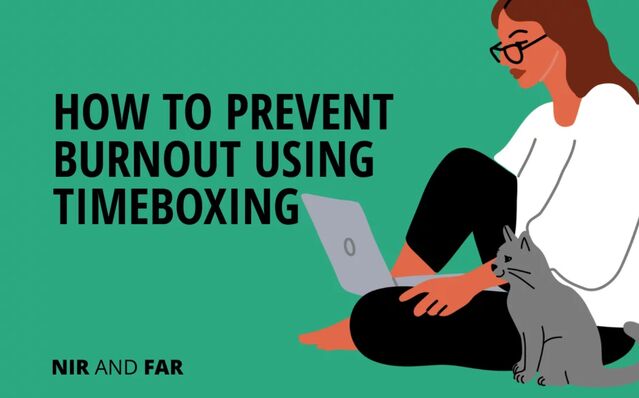Burnout
How to Prevent Burnout Using Timeboxing
We’re facing a burnout epidemic that goes beyond work.
Posted September 22, 2022 Reviewed by Vanessa Lancaster
Key points
- Timeboxing is a time management technique that helps you ensure you don’t spend more time than you want on any one thing.
- Timeboxing gives us insight into what we can realistically fit into one day and enables us to find a better balance for all our values.
- By pinpointing our values and ensuring that those get time in our schedule, we can at least find a balance between doing what we have to do.

We’re facing a burnout epidemic that goes beyond work. Understanding its causes can help us fix it.
A 2021 Indeed survey showed that 52 percent of 1,500 American respondents feel burned out, compared with 43 percent the previous year; 67 percent believe burnout worsened during the COVID-19 pandemic.
That’s not surprising.
People who worked from home during the COVID-19 pandemic ended up working more: The same Indeed survey found that 53 percent of virtual employees work more hours now than they did in the office.
That nationwide job burnout inspired two movements: the Great Resignation—a record number of 47.4 million Americans voluntarily quit their job in 2021—or they’re doing the bare minimum at work.
Job burnout isn’t the only kind of burnout.
Burnout can also rear its head in our relationships domain, especially in parenting, caretaking, or romantic relationships, all of which were challenged during the COVID-19 pandemic.
Romantic relationships were put to the test as many found themselves spending unlimited time together without a break. Parents tried to care for their kids, help them navigate virtual schooling, and work simultaneously in the same space.
The lines between every domain of life were blurred, so controlling how we spend our time became more complicated. We could no longer rely on physical boundaries to establish the boundaries we needed.
No wonder burnout increased so dramatically.
There is a time management technique that helps to combat burnout by reestablishing those lost boundaries. But what causes burnout, and how can we avoid it?
There’s a simple equation for figuring out how to avoid burnout.
Identify the Cause
According to Psychology Today, burnout is a state of emotional, mental, and often physical exhaustion brought on by prolonged or repeated stress.
Further delineating that definition, I recently tweeted:

The pandemic was the perfect breeding ground for this because we were suddenly expected to take on so much without having a precedent for how to handle that influx.
On Twitter, people responded with their own burnout formulas, all of which shared common themes.
One person said that burnout was a combination of trauma and workaholism. Another said it was “the accumulation of emotional debt beyond one’s capacity to self-regulate.”
Several people alluded to hustling or working long hours without purpose, clarity, direction, or enjoyment: "wage slaves." They suggested that the lack of a fundamental plan leads to slapdash action, which leads to burnout.
Others suggested that we don’t necessarily need to work less but make room in our lives for self-care and passion or the things that recharge us and enable us to reconnect with ourselves. Similarly, another person argued that burnout happens when we spend more time doing things we don’t like versus things we value.
Studies validate many of those replies.
For example, our personal interest in an activity improves our performance and delays burnout. And finding equilibrium is important, too: Robert Glazer, who extensively researched burnout for his book Elevate, told me, “Alleviating burnout doesn’t mean scaling back our workload; it’s more about reallocating our energy.”
Lack of control, work-life imbalance, and unclear or extreme work expectations are named among the causes of burnout by Jennifer Moss, author of The Burnout Epidemic.
All those burnout formulas can be balanced by effectively—and realistically—managing our time. And when it comes to time management, there is no better method than timeboxing.
Find Balance With Timeboxing
Timeboxing is a time management technique that helps you make sure you don’t spend more time than you want to on any one thing.
The key to timeboxing and fighting off burnout is to get really clear on how you want to spend your time.
What do you need to make it to become the person you want to be?
To answer that question, start by identifying your values.
Your values are attributes of the person you want to be. They are things that can’t be taken away from you.
Employment security, material possessions, and community are not values. Self-reliance, tolerance, and determination are.
When we define values as attributes of the people, we want to be. We can more clearly see our next steps and the actions we can take to move forward.
It helps to categorize your values into three life domains: yourself, your relationships, and your work (which can also include community service and side projects).
Of course, it’s a fact of life that we have to give time to things that we don’t necessarily want to do. We can’t all love our jobs all the time, but a large portion of our time is still dedicated to paid labor. When virtual schooling was the norm during the pandemic, many parents had to make time for their children’s education.
That only emphasizes the importance of using timeboxing to take control of your remaining time.
Timeboxing gives us insight into what we can realistically fit into one day and enables us to find a better balance for all our values.
Without timeboxing, the chance of you finding some semblance of a balance drops.
By pinpointing our values and ensuring that those get time in our schedule, we can at least find a balance between doing what we have to do—even if we don’t want to—and doing what we want to do.
What’s more, reframing the actions we make time for in our calendar can give us a new perspective. You may not love your job, but it helps you fulfill your value of being self-reliant or a good partner or parent.
Getting clear on our values and how we spend our time reminds us why we do those things.
Using timeboxing, you can make the most of your time. And when we find that control, we block burnout.
A version of this post appears on NirAndFar.com.




